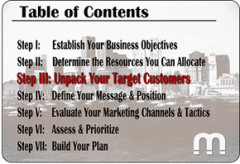Magnetude Blog Series: A First-Time Founder's Guide to Building a Marketing Plan (Step III)

Welcome back to Magnetude Mondays. This week we would like to provide insight into getting to know your target customer.
Step III: Unpack Your Target Customer
By the time your organization has reached this point in your maturity, you have likely given quite a bit of thought to your target customer. At this juncture, it’s important to go one step deeper and build a robust profile of your target customer—not just their demographic makeup, but also their psyche and the world that surrounds them, professionally (and sometimes) personally.
Market research, whether conducted internally or by an expert, is important not only to find the right customers, but also to deeply understand how to appeal to their needs and inherently understand what motivates them.
Key Questions to Ask Yourself:
Before confirming your target market, be sure you understand why you are choosing the targets you select. For example, are you focusing on the market segment that has the greatest pain that you can help solve? Or are you prioritizing segments that will be easiest to sell to or access? These considerations can, and likely will, change over time, but it is important to be upfront about your rationale for prioritizing one segment over another.
Target Organizations
- Which types of organizations do we want to go after? Are they of a certain size, geography, industry, and maturity level?
- What are the features of these organizations that can make them easy to identify?
- Is our business model optimized for our target segment?
- Are there any triggering events in their world that would make our solution more compelling to them? How do we track these?
Target User Roles
- Roles: Which roles within an organization will we market and sell to? Is there a single role that will use our solution? Or are we relevant to multiple divisions or departments within an organization? Which of these have the strongest pain points that we can help solve/alleviate?
- User versus Decision Maker: Are the users and decision makers of our product different? If so, do we need to appeal to both?
- Procurement Process: Who is involved in the customer’s procurement process? Who signs off on the project and approves the budget? What will the likely objections be? How can we address this in our business model?
- Demographics: For our key users and decision makers, what do we know about them? Do they fall within a specific demographic profile regarding age, education level, gender and such?
- Behaviors & motivations: What do we know about their behavioral characteristics? Do they aspire to have their boss’ job? Do they wish they had more time to focus on strategic tasks?
- Influences: What do they read? What events do they attend? Who are the influencers in their space? Which social media sites are they likely to engage in? Which professional associations or accreditation organizations do they require?
- Language: How do they talk about their pain points? What words do they use?
- Competitive: How do they currently try to solve the pain we can help them solve? Is it with competitive products?
As you can see, the questions multiply as you get down to a very granular understanding of your customer. Think about how to best prioritize collecting this data. Perhaps you can learn from your beta customers and have a consultant interview them in greater detail. Another method could be to prioritize a specific job title and build a robust profile of their behaviors and motivators. A third approach is to connect with other firms that sell to your target audience, such as a distributor.
Join us next Monday, when we help you “Define your Messaging and Positioning”.
If you are checking us out for the first time, and would like to read Steps I & II, you can find them here:
Stay up to date with our latest blog posts by following us on Twitter, or contact us.